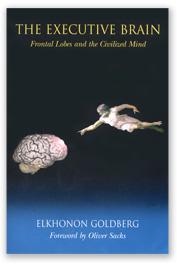The Executive Brain: Frontal Lobes and the Civilized Mind
Author(s): |
Elkhonon Goldberg |
Publishers: |
Oxford University Press |
Edition: |
2001 |
ISBN: |
0195156307 |
Click here to purchase
All sales commission goes to charity
< Back to list |
 |
| |
|
The Executive Brain is a truly great book but a challenging read. The author, Elkhonen Goldberg is clearly an extremely clever man and, like all great scientists, his thoughts move beyond the somewhat arbitrary boundaries of science and into the realms of philosophy. This is not surprising as the subject of the book is the frontal lobes of the cerebral cortex, arguably the part of the brain that, above all others, sets man apart from other animals.
Oliver Sacks, who wrote the foreword compares the book to the works of Edelman and Damasio in addressing "how nature and culture interact, and how brain and mind produce each other".
The book begins by providing an interesting insight into Goldberg's background in communist Russia. He was fortunate to study for his doctorate under the great neuropsychologist Alexander Luria at the University of Moscow, but he knew that as a Jew his future opportunities would be limited. He therefore faced a dilemma, if he were to be regarded as an asset to the state he would not be allowed to emigrate, on the other hand, he was committed to his research. In the end he decided to deliberately sabotage his academic work, leave the university and take a lowly job as a hospital porter. It worked and he was granted a visa to emigrate to the United States. The rest, as they say, is history.
Playing this intricate and contradictory game, he explains, was the most intricate game he has had to play in his life, employing the sort of cunning and insights into the minds of others that only the frontal lobes can provide.
Goldberg describes the frontal lobes as providing the "executive functions" - a link to all the other functions of the brain at a cognitive level. He draws an analogy with the conductor of an orchestra, who is interested in the totality of the music, but not responsible for playing or being able to play any particular instrument. In this way he suggests that everything we might ever care about - what makes us human - is mediated by the frontal lobes.
Goldberg draws a distinction between different types and levels of consciousness. He points out that even people with significant damage to the frontal lobes exhibit consciousness, but it is restricted to the type of consciousness found in lower-order animals, the type that enables them to eat, sleep, reproduce, move around and so on. The type of consciousness that exists in the frontal lobes is that which enables humans to perceive themselves in the context of their past, what I call "narrative consciousness".
As Goldberg points out, not only does this higher-level consciousness provide us with a historical context for our lives, but it also influences our thinking as humans, to a much greater extent than any other species, are guided by previously accumulated knowledge. In effect, the older and more knowledgeable we get, the more set in our ways we become.
This raises the question of right and left hemisphere differentiation as, the left hemisphere is generally thought to be more logical and structured and the right hemisphere more freewheeling and holistic. Goldberg reinforces this view by drawing a distinction between novelty and routine. In his view, the left hemisphere of the frontal lobe deals more with routine while the right deals with novelty. Thus, the right frontal lobe plays a key role in learning as all new things are novel to begin with. He also notes that right hemispheral damage is relatively more debilitating when it occurs in children as more of their experiences are novel, in the case of adults, left hemispheral damage is relatively more debilitating.
In the context of Brain Dominance, this is not to say that children are "right-brained" and adults "left-brained", simply that the learning process places greater emphasis on the right frontal lobe when learning or encountering new experiences.
In the final chapter Goldberg makes the huge conceptual leap of comparing the evolution of the human brain to the development of human society, man-made processes and institutions. As he says; "Each is characterized by a transition from the modular principle of organization to the distributed, gradiental principle. At a highly evolved stage of this process, a system of "executive" control emerges, to help rein in the prospect of anarchy and chaos, which paradoxically increases with the increase of any system's complexity."
Ho goes on to suggest that in the future brain science may be able "to offer its own heuristic metaphors to shed light on other complex systems, including society".
While I can see Goldberg's point, I do not believe that we can attribute cause and effect to the relationship between brain structure and organisational structures in society, but the question is intriguing.
In conclusion, The Executive Brain provides a great collection of well-described personal and clinical observations that offer an engaging and informative overview of the frontal lobes as the part of the brain that enables our humanity. A heavy read, but well worth the effort.
Published January 2009